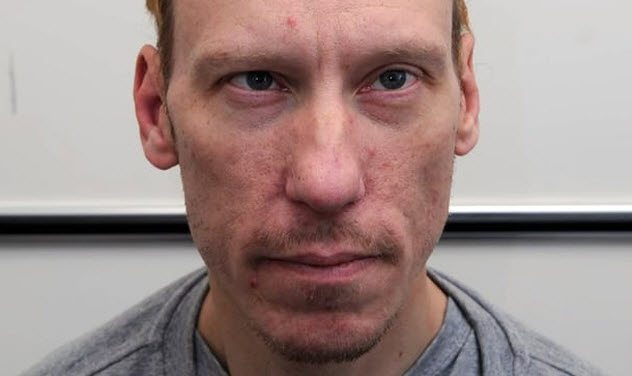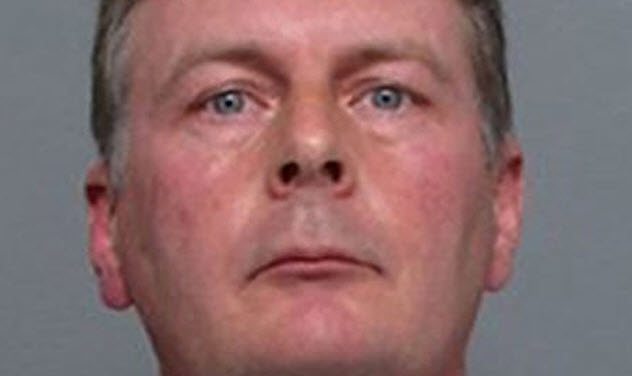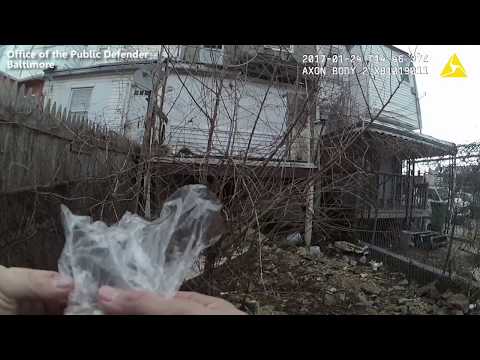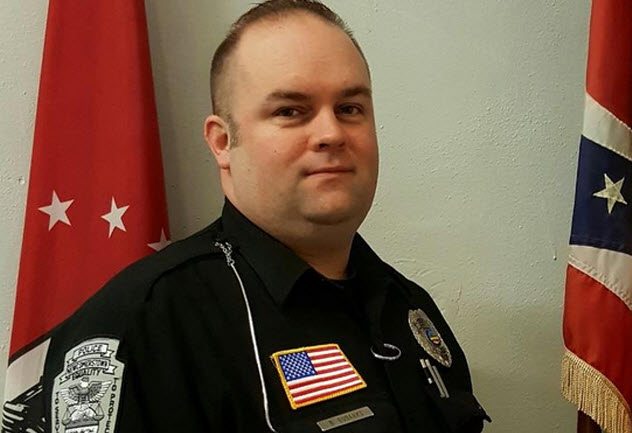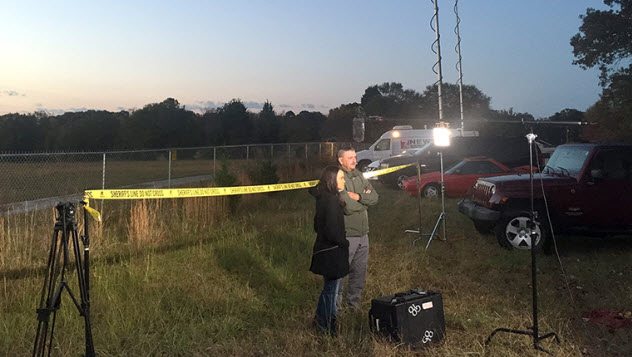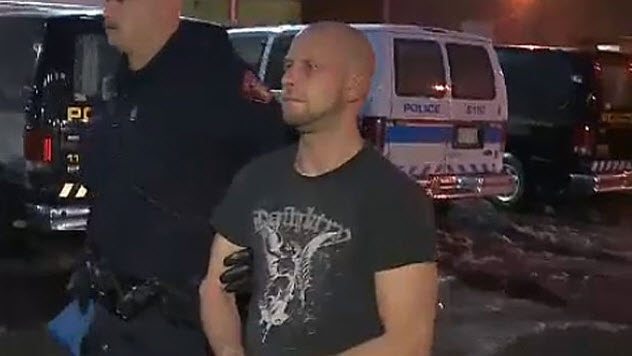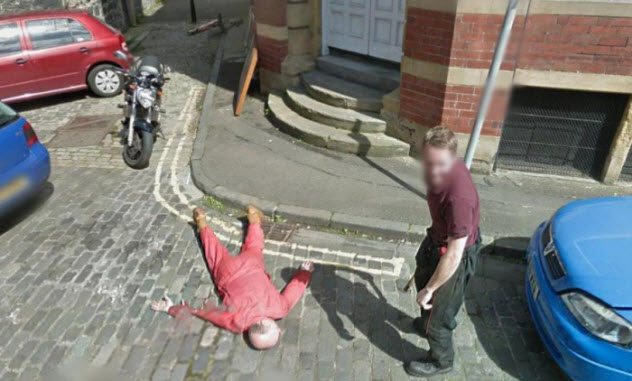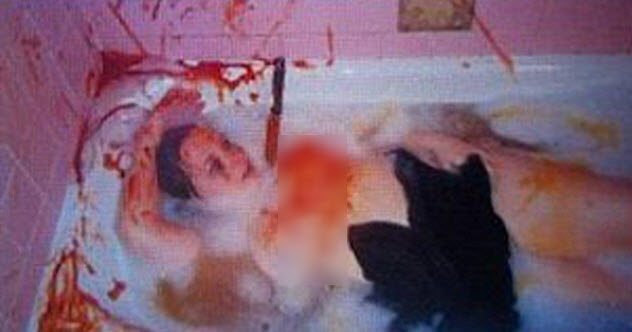If you’re wondering how and why this happens, we’re about to tell you the stories of 10 faked crime scenes. The motivations for staging these events varied from the sinister to the noble to the outright bizarre. Even elementary school teachers have gotten in on the act.
10 Too Many Coincidences
In September 2014, Daniel Whitworth, 21, was found dead in an East London graveyard by a dog walker. In his hand, Whitworth held what was both a suicide note and a murder confession. According to the note, Whitworth had accidentally injected a man called Gabriel Kovari with a fatal dose of the date rape drug GHB while they were having sex a month earlier. Unable to live with himself, Whitworth had taken his own life. Some details of the note certainly fit. A month earlier, Gabriel Kovari had been found dead of an overdose of GHB. Strangely, he had been discovered in the same graveyard and in the same position as Whitworth by the same dog walker. Although this wasn’t the only odd thing about the circumstances, the police took the note at face value. No investigations were carried out. This seems rather remarkable because another young man, 23-year-old Anthony Walgate, had died of a GHB overdose not far from the graveyard a few months earlier. Walgate was apparently discovered by Stephen Port, 41, who was later found to have lied about finding Walgate outside his flat rather than inside it. Port was sentenced to eight months in prison for making a false statement to police. Yet they continued to believe that the young man’s death was due to an accidental overdose. Port was released early. Not long after, a fourth dead man was found in the same graveyard as Whitworth and Kovari. Jack Taylor, 25, had been found with a syringe in his pocket. Still, police did not link the deaths and no further investigation was carried out. It was Jack’s family who finally started to piece the story together and push for the police to carry out a proper inquiry. Eventually, Port was arrested and charged with all four murders. He had lured the young men to their deaths through apps such as Grindr. The fact that he had attempted to frame one victim for the murder of another adds a particularly cruel twist. He was later sentenced to life in prison. The authorities are looking into another 58 unexplained deaths, and the families of the victims have demanded an investigation into how police missed so many clues for so long.[1]
9 Selective Memory
In Oadby, Leicestershire, witnesses initially believed that the driver of the car that had just crashed into a tree at 80 kilometers per hour (50 mph) was unconscious. Beside him, a woman lay slumped with catastrophic injuries from which she wouldn’t recover. On a closer look, it was clear that the driver wasn’t unconscious at all. He seemed to be pretending and keeping his eyes shut “like a child.” When he finally “regained” consciousness, he claimed he could remember nothing until a month later when pieces began to come back in nightmares. Then he recalled his leg having a spasm which had made him unable to hit the brakes as he sped toward the tree. But those who knew the woman next to him were remembering things, too. Sally Lawrence, 47, had been in the process of divorcing the man who was driving the car that day in October 2012. She had predicted that Iain Lawrence, 53, whom she described as “cold and calm,” would try to kill her. He was a jealous man and was unhappy about the financial settlement in the divorce. But why had she died and he survived uninjured? It’s true that he had forewarning of the crash, seeing as he had deliberately put his foot on the accelerator and was therefore able to put himself into the brace position. But further investigation revealed that the airbag on the passenger side had been disabled. Also, Iain Lawrence had actually undone Sally’s seat belt moments before the crash just to make absolutely sure that she wouldn’t survive. The former commercial airline pilot was sentenced to life imprisonment.[2]
8 Filmed In The Act
When we think of a person faking a crime scene, our first thought is usually that it’s the original criminal trying to cover his or her tracks. But sometimes, police officers are so eager to meet their arrest quotas that they go that extra mile. And sometimes, they seriously mess up while doing so. In early 2017, police officer Richard Pinheiro used his bodycam to film himself discovering a stash of drugs under some trash in an alleyway. Pinheiro and his colleagues had been watching a spot in Baltimore known to be frequented by drug dealers. To speed up the judicial process, he turned on his bodycam and then found his way quickly to the bag of pills hidden in a drink can. However, he didn’t realize—or had forgotten—that bodycams often record the last 30 seconds of footage before they are activated and had captured Pinheiro planting the drugs in the first place while two colleagues looked on.[3] The case against the associated defendant was later dropped after the video surfaced. As an investigation into Pinheiro was launched, one police officer was suspended and two others were given administrative duties.
7 No Witnesses
Although reprehensible, the motive for Officer Richard Pinheiro’s staged crime scene in Baltimore was fairly standard. However, it’s not often that a police officer will fake a crime scene out of embarrassment. In Newcomerstown, Ohio, police officer Brian Eubanks, 37, sent out a call in early 2017 saying that he had been pursuing two suspects in his patrol car when they began shooting at him from their vehicle. Eubanks had been injured in the arm. An alert was quickly put out, and a photo of one of the suspects was made public. But as police investigated further, they found more than one inconsistency in the story. By using an automatic license plate reader, they were able to find people who were passing Eubanks at the exact moment that he claimed to be in pursuit. Yet none of them remembered the vehicle he described, let alone a pursuit that ended with a shoot-out. Eubanks was brought in for questioning and quickly admitted that he had made up the whole thing. The reason? Tragically, he had attempted to take his own life but had messed up and presumably felt too ashamed to admit what had happened.[4] The picture of the “suspect” was taken down, and a statement of his innocence was released. Meanwhile, Eubanks returned to his family to receive treatment for his “state of mind” while the investigation continued.
6 Making The News
It’s a given that criminals will fake crime scenes from time to time and an unfortunate reality that police officers will sometimes do the same. But journalists? Surely not. In 2016, ABC news reporter Linsey Davis was filmed while standing in front of a strip of police tape in Woodruff, South Carolina. This is an image that suggests the police have been on the scene and secured the area and that we are looking at the site of a crime. Not in this instance. A photograph taken at the time shows that the “police tape” only extended 9 meters (30 ft) and was actually tied to the camera crew’s equipment. It was seemingly brought in by the production company to add a touch of authenticity to the shot. This was especially strange because Linsey was standing in front of an empty field and the story on which she was reporting concerned a woman allegedly held by a sex offender in a container some distance away. Once a vice president at ABC News was made aware of this, she declared it completely unacceptable and said that the producer had been “taken out of the field.”[5]
5 Slow Burner
In December 2013, a woman was maneuvering her car in Calgary, Canada, when she struck a parked vehicle, damaging the front and rear doors. When the owner returned, she approached him, explaining what had happened and citing the conditions on the road that winter as the cause of the accident. The man, who was in his late thirties, was not pleased. But after the woman had explained that her car was a business car and that she would pay for all damages without the need to get insurance companies involved, he seemed to come around slightly. So they swapped details, and she got the man to call her boss at the marketing firm where she worked. The man agreed with the boss to get a repair estimate for the damage. They settled on a $1,000 payment, and the woman even offered the man Flames tickets as an extra goodwill gesture for the inconvenience caused and for his willingness to settle without involving insurance companies. On December 4, the two met up so that the money could exchange hands. Then they had a meal together and she listened as he talked about his children and his plans for Christmas. Soon, a friendship blossomed and the two kept in touch via texts and phone calls for the next year and a half. They shared difficulties from their own lives. Difficulties such as the man having had bad relationships in the past. And that he had strangled his wife to death and buried her in the basement.[6] That was all the woman needed. She was actually an undercover police officer. Her sting, which had started with her deliberately driving into her suspect’s parked car, was over. Her target, Allan Shyback, was arrested and charged with the second-degree murder of Lisa Mitchell, whose partially mummified remains were subsequently exhumed from beneath the concrete floor of the basement.
4 Hunted
It was the second day of the 1995 hunting season in the Colorado wilderness, and Bruce Dodson was walking alongside a piece of fencing when the first bullet struck him. It passed through his clothing but only grazed his skin. Realizing that he had wandered into the line of fire of fellow hunters, he quickly removed his orange vest and began to wave it in the direction from which the bullet had come, trying to make it clear that he wasn’t prey. It was then that the second bullet struck him in the chest. As he fell to the ground, he was shot a third time in the back. When the police arrived on the scene, Bruce’s wife, Janice, was highly distressed and police believed that they were dealing with a tragic hunting accident. Except that it’s rare for someone to be accidentally shot three times. They soon traced the bullet’s path to a hunting spot where a matching cartridge was found. The cartridge didn’t fit any of the guns that either Bruce or Janice was hunting with. However, it did match a gun that Janice’s ex-husband, J.C. Lee, had reported stolen the day before. Oddly enough, J.C. was camping just 1.2 kilometers (0.75 mi) away from where the Dodsons had set up their camp. What was also strange was that Janice had traveled to the same spot without her husband just a few weeks earlier. She had been married to Bruce for only three months and stood to gain financially from his death. She had already had wills done, taken out three life insurance policies, and convinced Bruce to put the titles to his two houses into both their names.[7] Within a month of his death, she had closed his bank accounts and cashed in his IRAs. She had also sold one of the houses as well as another property, his car, and even his horse, Glory. But police didn’t have definitive proof—until they checked the clothes Janice had been wearing at the time of the shooting. They discovered a particular type of mud on her clothing that was only found in the area where her ex-husband had been camping, the same place from which his gun had been stolen. It was this evidence that ultimately led to Janice Dodson being imprisoned for life.
3 Google Was The Witness
We’ve all conducted searches of destinations to see images on Google Street View. In August 2013, someone was having an online look around some streets in Edinburgh, Scotland, when they came across something unexpected. In the image, one man in overalls stood over another man in overalls who was lying, apparently unconscious, on the pavement. In the hand of the standing man was a pickaxe handle. It seemed like a serious assault had just taken place, and the viewer contacted the police. They quickly ascertained that the image had been captured a whole year before, but this didn’t stop them from investigating. They soon found themselves paying a visit to Dan Thompson, 56, who bore a resemblance to the man lying on the ground in the picture (at least as far as they could tell from the image of the back of his head).[8] But Thompson, a mechanic, had not suffered an attack in the last year, and he quickly apologized for the prank he had played. It turns out that he had spotted the Google camera car one day while at his job as a mechanic. He quickly called a colleague onto the road and got the man to stand over him with the pickaxe handle while Thompson pretended to have just been murdered. “There are pictures of men flashing their bums on Google, but we thought we would be more classy,” Thompson said. Luckily, the police saw the funny side and no charges were filed.
2 Modern Education
So we’ve learned that criminals, police officers, journalists, and the odd mechanic all fake crime scenes. We can cope with this. It’s not like teachers at elementary schools have created false crime scenes and traumatized a bunch of young children. Okay, so maybe they have at certain elementary schools in England. In 2009, a female teacher at Foxhill Primary School in Sheffield pretended that she had been hit over the head by an assailant during a break-in. Unfortunately, it didn’t knock any sense into her—real or fake. Unaware of the mock nature of the crime scene, children as young as five walked into the school to find an area with a pool of fake blood cordoned off with police tape. For four days, the teachers maintained this cruel fiction. Supposedly, it was a learning experience designed to stimulate the kids’ creativity—if not their nightmares—as they worked with a real crime scene investigator to solve the mystery. The parents were not amused.[9] But in some sections of the UK school system, this was child’s play. Not to be outdone, the teachers at Brooke Hill Academy in Oakham took elementary crime scene investigation to the next level in 2017. Yes, these education professionals decided to stage a murder for their unsuspecting grade school pupils (once again as young as five) in which the victim was left with only one foot. Upon entering their classroom, the kids came upon a bloodied area cordoned off with police tape which contained the chalk outline of the fake murder victim with the missing foot. The alleged foot was characterized as having been “stolen” because describing it as having been “hacked off” would presumably be upsetting for a group of five-year-olds. Police officers were also in attendance, and the schoolchildren’s fingerprints were taken with flour. (The use of flour is not standard practice in England despite all the old Victorian mills.) Again, some parents raised concerns. One mother said that she felt the school went “a bit far,” and there were stories of children waking up in tears at night due to the grisly scene. The headteacher was unrepentant, however, and felt that using such props inspired the children to learn. Either that or they came away desensitized to brutal crime at a very early age.
1 They Did What?
There are pranks that make people laugh, and there are pranks that people don’t find funny at all. And then there are pranks that end up with a criminal charge brought against you—which is where Micah Risner and his fiancee, Nataleigh Schlette, enter our story. Risner’s sister owed him some money. But instead of asking for it back, he got his fiancee to lie in a bath and cover herself in ketchup to simulate blood. Then he placed a kitchen knife beside her. Finally, Risner took a picture of the scene and texted it to his sister. He said that he and Schlette had gotten drunk the previous night and had a fight. When he woke up, he found her body in the bath. Unknown to his sister, Risner’s motive was to get her to come to his house so that he could retrieve his money. But his sister was understandably disturbed. Upon learning that the police had been called by other relatives (who had also received the images because, well, families share, right?), she advised him on how to cover up his crime. She told him to delete all the messages and throw his clothes in a dumpster “far away.” Both Risner and Schlette have since been charged with “inducing panic.” It is unclear whether Risner got his money back.[10]
